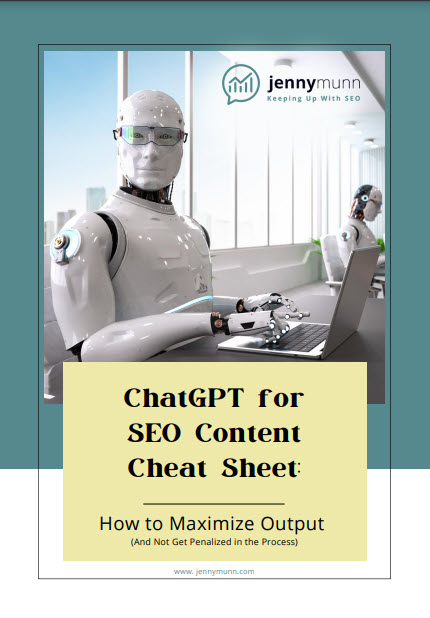When did you last conduct a quick and dirty SEO Competitive Audit?
When it comes to tracking your rankings, you will never get the competitive insight needed if you’re not manually observing what’s happening in the wild. And because we’re all short on time, I took my SEO Competitive Audit and abbreviated it into these 8 simple (and dare I say fun?) steps.
Step 1: Take off your marketing hat
Take off your marketing hat and step into the shoes of your objective prospective customer who is a great fit for your products and services. This step is non-negotiable and critical for SEO success. Are you ready to be objective and non-biased? Ok, then proceed.
Step 2: Know your most important keywords.
I suggest choosing 3 keywords:
- a relevant informational keyword
- a transactional keyword
- a brand keyword
If you don’t have your keywords in front of you, or this stresses you out to choose 3 among the thousands you have, I give you permission to use your best educated guess and roll with it (ahem, my perfectionists I’m talking to you). Also, in case this is not obvious, “keyword” is synonymous with “keyword phrase.”
Step 3: Open Google on your desktop
Open in incognito and search your keywords one at a time on desktop. First, search your selected informational keyword, then your transactional, then your branded keyword, and follow the analysis below for each.
Step 4: Take a look at the results—in context to how your organization
What do you see that’s there?
- What additional keywords were auto-suggested?
- Do you see the same competitors you expect to be there – in both paid and organic listings?
- Who are the new competitors (traditional and non-traditional) you see in both paid and organic listings
- What Google SERPS features are present?
- Where is your brand? Your website, your content, your assets, your visibility? If you’re not at the top of th organic listings, speculate why.
Step 5: Repeat the Google search analysis on mobile with the same 3 keywords
- Compare the differences and similarities of SERPS elements and competitors you saw on desktop versus mobile.

Step 6: Repeat the search analysis on a social media site (or two or three) with the same 3 keywords
- Open TikTok, YouTube, Instagram, Pinterest, LinkedIn, or whatever social media site your target market prefers.
- Analyze the content that’s coming up (articles, audio, video, imagery), and how your content (or lack of content) stacks up
- What influencers are present
- And don’t forget to document your insights and what you think you should “do” with what you’re seeing (or not seeing)

Step 7: Repeat the search analysis on Bard or ChatGPT with your informational keyword
Generative AI tools are the latest and scariest competitors. Here’s how to assess these tools from a competitive standpoint:
- Type your keywords, one at a time, into Bard or ChatGPT, or both for even more fun.
- When you type in your selected keywords, what content comes up? These tools have excellent intel into intent and what information consumers most likely want to know.
- Is that content represented on-site or off-site?
- How might your target market look for information from a generative AI tool vs. a Google search with the intent to click on a site?
- How can you make your content better than what generative AI is producing? Do you have that extra “E” for “Experience” in the updated E-E-A-T in your content that is absolutely positively critical to SEO success going forward?
- Are any competitive websites cited as sources?
- Do you think you’ll lose organic website traffic based on your current traffic, keywords, industry, and target audience who will use a generative AI tool for getting answers versus visiting a website?

Step 8: Make this Analysis Actionable. What Do You Do with These Findings?
And so, thinking in context for your brand, here are questions that will inform what you “do” with this information:
- Is your content up to par with high-ranking competitors?
- Are you producing the right type of content, in the right format?
- Are you creating content on the best platforms?
- What content or messaging gaps exist that need to be addressed?
- Do you see any new keyword opportunities to target?
- Are you confident you’re still targeting keywords that are the highest priority for your brand?
- Do you see new competitors you need to do a deeper analysis into?
Contrary to some opinions, AI is not going to cripple the digital marketing or SEO industry, but you do need to know how to insert AI-friendly best practices into your strategy while ensuring you’re doing all of the “normal” things you still need to do to increasing visibility and maintain the high rankings you do have.
Future-proofing Your Strategy
Conducting a quick SEO competitive audit is a surefire way to futureproof your brand while you’re busy in the day-to-day grind.
Futureproofing means bringing your current plan up to speed with where we are today and what content is being rewarded at this exact moment while anticipating the future to minimize decreases, drops, or downward trends.
Remember, with SEO, the name of the game is relevance, competitiveness, and being visible. Make sure you pull yourself out of the daily minutia to keep an eye on the bigger picture.
Jenny Munn
Latest posts by Jenny Munn (see all)
- Four 2024 SEO Planning Tips for World Domination - November 16, 2023
- SEO Planning Tip: Why You Need a CYA Clause - November 3, 2023
- How Long Does SEO Take to Show Results? (Updated for 2023) - August 9, 2023


